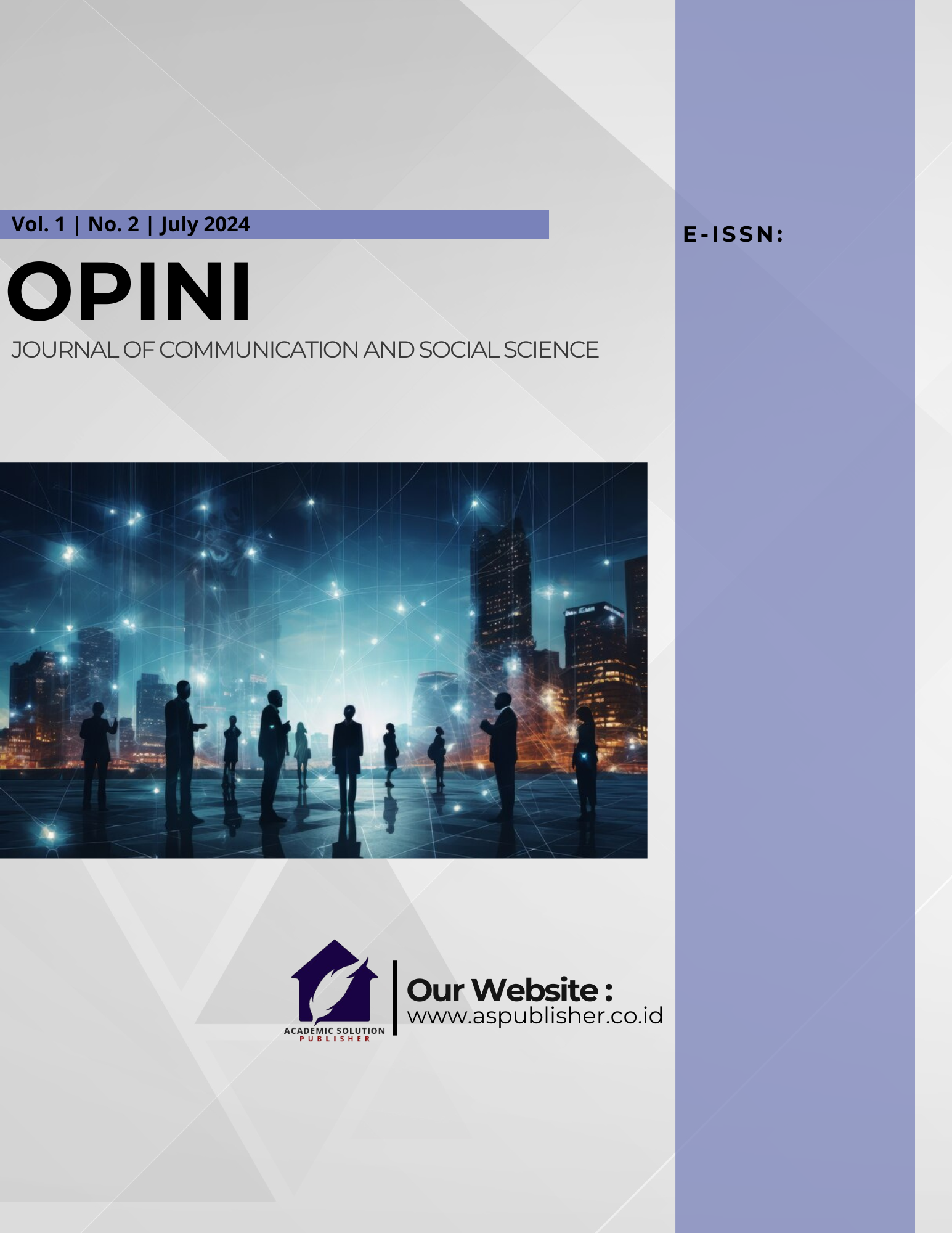THE ROLE OF JAVANESE CULTURE ON COMMUNICATION PATTERNS IN THE CAMPUS ENVIRONMENT
DOI:
https://doi.org/10.70489/opini.v1i2.313Keywords:
Javanese culture, communication patterns, students, campus environmentAbstract
This study explores the role of Javanese culture on communication patterns among communication science students in campus environments. Javanese culture, rich in values such as harmony, respect, and empathy, plays a pivotal role in shaping interactions among Javanese communication science students. Employing a qualitative descriptive approach, data was gathered through observations and in-depth interviews with Javanese communication science students at one of campuses in Java. Findings reveal that Javanese communication science students tend to engage in subtle communication and avoid direct conflicts, reflecting their efforts to maintain harmony in daily interactions. The formal and respectful communication patterns observed in their interactions with professors or senior peers also underscore their reverence for social hierarchies ingrained in Javanese culture. Furthermore, Javanese students demonstrate adeptness in adapting to multicultural environments, adjusting their communication styles without compromising their cultural values. Despite technological advances and the influence of social media, traditional Javanese cultural values persist in their online interactions, indicating cultural resilience amidst modernization. This study highlights the significance of cultural education in preserving Javanese cultural identity among students and enhancing understanding and appreciation of cultural diversity on campus. It provides insights into local cultural dynamics within the context of higher education and its relevance in an increasingly interconnected global era.
References
Dalimunthe, M. A., Pallathadka, H., Muda, I., Devi Manoharmayum, D., Habib Shah, A., Alekseevna Prodanova, N., Elmirzayevich Mamarajabov, M., & Singer, N. (2023). Challenges of Islamic education in the new era of information and communication technologies. HTS Teologiese Studies / Theological Studies, 79(1). https://doi.org/10.4102/hts.v79i1.8608.
Fauzan, I., Arifin, A., Dalimunthe, M. A., & Rahmadani, S. (2023). The configuration of ethnic and religious relations towards the 2024 general election: A case study in Medan, Indonesia. Multidisciplinary Science Journal, 6(2), 2024006. https://doi.org/10.31893/multiscience.2024006.
Firmando, HB. (2013). Social Change in the Traditional Death Ceremony of the Toba Batak Ethnicity in Medan City. Retrieved from https://repository.usu.ac.id/handle/123456789/5010.
Humaizi, Hasan NNN, Dalimunthe MA, Ramadhani E. (2024). Harmony in virtual space: Forum Kerukunan Umat Beragama (FKUB) development communication in creating digital literacy based on religious moderation. Journal of Infrastructure, Policy and Development. 8(7): 4299. https://doi.org/10.24294/jipd.v8i7.4299.
Indainanto, Y. I., Dalimunthe, M. A., Sazali, H., Rubino, & Kholil, S. (2023). Islamic Communication in Voicing Religious Moderation as an Effort to Prevent Conflicts of Differences in Beliefs. Pharos Journal of Theology, 104(4). https://doi.org/10.46222/pharosjot.104.415.
Lexy. J Moleong, (2012). Qualitative Research Methodology revised edition 2012. Bandung: Teen Rosdakarya, page: 5
Muhammad Nurdinah 2017. Resistance Of Urban Communities And Traditional Communities In Responding To Social Change. Vol 19 no 2
Nanda, S. (2024). Qualitative Research Methods: Definition, Types, & Examples. Taken from brain academy: https://www.brainacademy.id/blog/methodpenelitian-kualitatif
Richie, J (2012). Qualitative Research Methodology. Bandung: PT Teen
Ritonga AR, Veronica A, Ginting LDCU, et al. (2024). Library Promotion In The Development Of The Universitas Sumatera Utara Towards A World-Class University. Journal of Infrastructure, Policy and Development. 8(6): 4149. https://doi.org/10.24294/jipd.v8i6.4149
Ritonga, A., Dalimunthe, M., Veronica, A., Ginting, L. (2023). The Effectiveness of Social Media As A Promotional Medium Of The University Of Sumatera Utara (USU) Library. Talenta Conference Series: Local Wisdom, Social, and Arts (LWSA) 6 (3), 16-20.
Sikumbang, A. T., Dalimunthe, M. A., Kholil, S., & Nasution, N. F. (2024). Digital Da'wah Indonesia Ulema in the Discourse of Theology. Pharos Journal of Theology. 105(1). 1-14. https://doi.org/10.46222/pharosjot.1051.
Suhendar, A., & Rambe, R. F. A. K. (2023). Group Discussion Effectiveness in Increasing Student Learning Interest in Pancasila and Citizenship Education Subjects. Pancasila and Civics Education Journal (PCEJ), 2(2), 9-12.
Suhendar, A., Azis, D., Yusoff, M. Z. M., & Utami, A. R. (2024). Optimizing citizenship education for ecological awareness: Analysis of the effectiveness of the lihat sampah ambil (LISA) program in environmental conservation. Journal of Professional Learning and Sustainable Education, 1(1), 17-26.
Wibisono, A. (2019). Understanding Qualitative Research Methods. Taken from the Ministry of Finance of the Republic of Indonesia: https://www.djkn.kemenkeu.go.id/article/baca/12773/memahami-methodpenelitian-kualitat
Zurnali, C. (2004), The Influence of Training and Motivation on the Productive Behavior of Employees in the Long Distance Division of PT Telkom Tbk, Thesis, Unpad, Bandung.
Downloads
Published
Issue
Section
License

This work is licensed under a Creative Commons Attribution-ShareAlike 4.0 International License.








